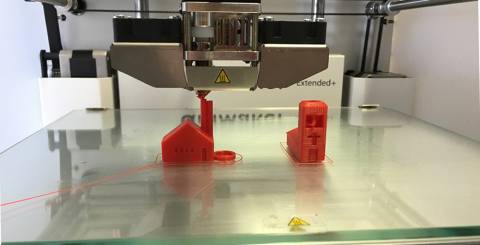5 Ways 3D Printing Will Change the World

3D printing has advanced at a remarkable rate in the past several years. Even though it was invented in the 1908s, the technology has just started becoming a revolutionary form of manufacturing. With its many uses and applications, it has the ability to be implemented in a variety of industries.
Thanks to the low prices and reliable technology, 3D printers are becoming common in small businesses, schools, and even homes. Engineers and scientists continue to expand the possibilities of the technology, developing new materials for printing objects that have a breathtaking potential to change the world. Here are five of the many ways 3D printing will influence the future.
1. Architecture
Construction using “ink” containing building materials such as steel and fiberglass as well as cement and recycled materials can revolutionize the way cities provide housing for the poor. Housing continues to challenge populations around the world as an increasing number of people cannot afford a place to live.
WinSun, a Chinese company, has found a way to use 3D printing technology to “print” affordable housing. The company first demonstrated its capabilities by printing a house in a single day for a cost of just $4,800. Since then, WinSun has printed a five-story apartment building as well as a villa. The company is expected to expand to twenty countries within the next several years, revolutionizing the way people think about construction as architects continue creating new designs.
2. Medicine
Eye-popping developments in the medical industry promise to make new treatments and devices available to you in the near future. Already, 3D printers create inexpensive prosthetics used to serve victims of war in some of the poorest areas of the globe.
Developing 3D technologies promise to deliver the capability of printing exact replacements for human body parts, including bone implants and limbs. Your dentist might soon have the ability to print crowns and replacement teeth on the spot, reducing the time required for dental procedures while improving their quality.
The news that 3D printing technology can save lives shouldn't surprise you. Researchers have already developed 3D printers that create living stem cells, giving them the ability to create tissue and organs that might soon transform the medical transplant industry.
3. Manufacturing
Printing 3D objects has turned the future of the manufacturing industry upside down. Companies can design products and bring them to market in record time using new modeling technologies.
Ove on the most beneficial advantages of 3D printing is the ability to produce customized items. As a result, many small businesses now have the ability to create specialized products and customize them for individual consumers, opening new opportunities for marketing and sales.
You should expect to see increasingly sophisticated three-dimensional outputs in shapes and structures that you might have thought were impossible to create using printer technologies. Some analysts suggest that the world might enter a new age of industrialization that eliminates factories and assembly lines, replacing them with 3D printers located on customer premises. In such a world, companies might print goods including apparel and toys directly to shoppers’ 3D printers after receiving an online order.
4. Replacement Parts
Engineers have designed 3D printers that can produce parts for everything from airplanes to engines, extending the life of products that otherwise require replacement. If a part of your vacuum cleaner goes bad, for example, you might soon have the option to print out a new component rather than buying a new unit.
A website called Thingiverse already gives you access to more than two thousand replacement parts that you can download and print from your own 3D printer, right from the comfort of your own home. Spare parts for everything from wristwatches to vehicles are now available and give you a glimpse of what the future holds.
5. Cars
Companies have used 3D printers to create vehicle parts for a long time, but they now aim to print entire vehicles. Jim Kor, an inventor, and his engineering team have demonstrated the feasibility of printed vehicles by printing the Urbee 2. Although not ready for everyday use, the three-wheeled, two-passenger car suggests that you will soon think differently about driving. For example, manufacturers will eventually have the ability to create precise designs that introduce new levels of fuel efficiency as well as new lightweight materials that have incredible strength.
Wrapping It Up
3D printing technology will likely make our present world obsolete. New construction techniques promise to make buildings faster and less expensive to build while manufacturing will make mass product customizations possible. At the same time, the widespread availability of replacement parts will extend the life of machines and appliances while 3D printed organs will extend human lifespans. Practically every part of life will change as researchers develop new innovative ways to use 3D printing to improve everyday life.
Similar Articles
Compare hydraulic and traction residential elevators to find the best fit for your home. Learn how each system works, their pros and cons, space needs, energy use, and maintenance requirements.
Extend the lifespan of your commercial marina docks with proactive maintenance. Learn essential inspection routines, material-specific care, and safety tips to protect your investment and ensure long-term dock performance.
Learn the key factors in designing an engineered fall protection system. Discover how hierarchy of controls, task analysis, structural integrity, and fall clearance ensure safety and compliance.
Today, modern businesses face constant pressure to operate with maximum efficiency. This requires a technology infrastructure that is both agile and robust. However, the traditional model of on-premises data centers often has significant limitations. These legacy systems can drain valuable resources from teams.
When people are hungry, standing in line for a table feels tiring and unpleasant. In fact, research shows that most individuals will just walk away if they have to wait longer. They will go and find another place to eat.
In the early stages of designing new community centers, fire stations and administration buildings, city planners and architects are forced to make a crucial decision: What building material is best suited for providing the most value, safety and longevity to the public?
Amazon Simple Queue Service (SQS), Simple Notification Service (SNS), and EventBridge are just a few of the messaging services that AWS provides to meet various demands when it comes to creating scalable and effective cloud systems.
Wearable technology, embracing devices small enough to be worn unobtrusively, constitutes a market that keeps expanding, and the momentum shows little sign of slowing
For job seekers, grasping the basic functions of Applicant Tracking Systems (ATS) is the first step in overcoming common job search barriers.









